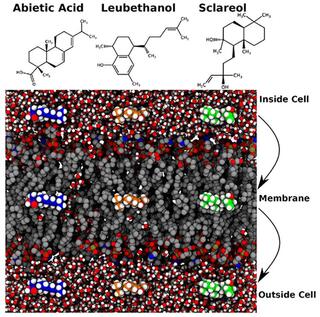Plant terpenoid permeability through biological membranes explored via molecular simulations
S. Raza et al. "Plant terpenoid permeability through biological membranes explored via molecular simulations" The Journal of Physical Chemistry B 127:1144-1157 (2023) [DOI:10.1021/acs.jpcb.2c07209]
Plants synthesize small molecule diterpenes composed of 20 carbons from precursor isopentenyl diphosphate and dimethylallyl disphosphate, manufacturing diverse compounds used for defense, signaling, and other functions. Industrially, diterpenes are used as natural aromas and flavoring, as pharmaceuticals, and as natural insecticides or repellents. Despite diterpene ubiquity in plant systems, it remains unknown how plants control diterpene localization and transport. For many other small molecules, plant cells maintain transport proteins that control compound compartmentalization. However, for most diterpene compounds, specific transport proteins have not been identified, and so it has been hypothesized that diterpenes may cross biological membranes passively. Through molecular simulation, we study membrane transport for three complex diterpenes from among the many made by members of the Lamiaceae family to determine their permeability coefficient across plasma membrane models. To facilitate accurate simulation, the intermolecular interactions for leubethanol, abietic acid, and sclareol were parametrized through the standard CHARMM methodology for incorporation into molecular simulations. To evaluate the effect of membrane composition on permeability, we simulate the three diterpenes in two membrane models derived from sorghum and yeast lipidomics data. We track permeation events within our unbiased simulations, and compare implied permeation coefficients with those calculated from Replica Exchange Umbrella Sampling calculations using the inhomogeneous solubility diffusion model. The diterpenes are observed to permeate freely through these membranes, indicating that a transport protein may not be needed to export these small molecules from plant cells. Moreover, the permeability is observed to be greater for plant-like membrane compositions when compared against animal-like membrane models. Increased permeability for diterpene molecules in plant membranes suggest that plants have tailored their membranes to facilitate low-energy transport processes for signaling molecules.
All input scripts to build and run molecular simulations are made publicly available on Zenodo.
